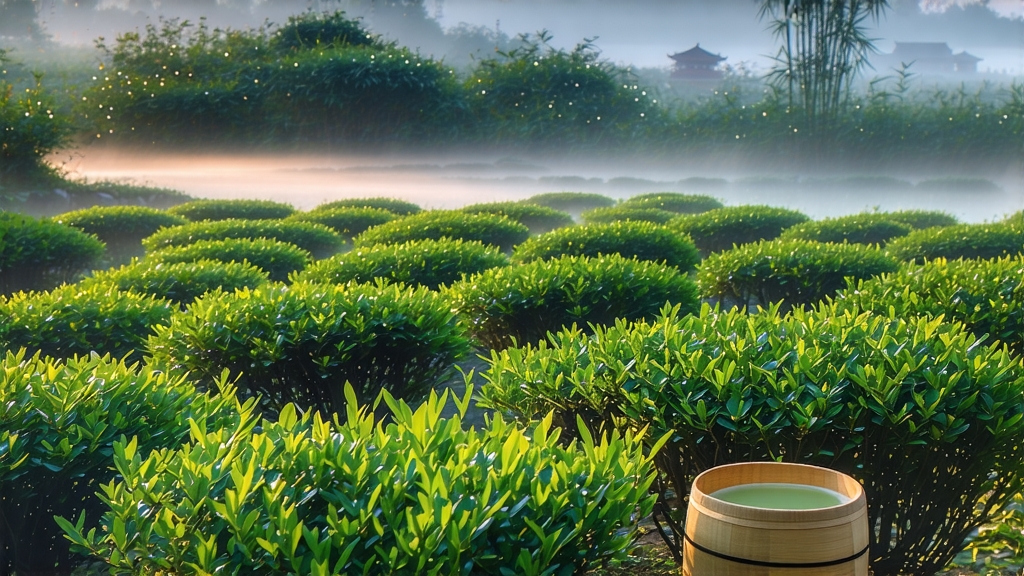
Longjing—often spelled Lung Ching in older texts—is the single green tea most Chinese households reserve for honored guests and their own quiet moments. To the Chinese palate it is the benchmark against which all other greens are judged; to the international drinker it is an accessible gateway into the vast universe of Chinese tea. Yet behind its gentle, jade-colored liquor lies a story of imperial patronage, microscopic soil differences, hand-to-wok choreography, and a fragrance that can vanish within months if the leaf is mishandled. This article walks you through that story, from the misty hillsides of West Lake to your own teapot, so you can brew Longjing with the same precision and reverence a Hangzhou farmer gives the first leaf of spring.
-
Historical echoes: from folk medicine to imperial tribute
Folklore places Longjing’s birth in the Song dynasty (960-1279), but verifiable records begin in the Ming, when monks at Longjing Village temple began pan-drying leaf to preserve its brightness. The tea’s fame crystallized in 1689, when the Kangxi Emperor visited West Lake, drank from a spring shaped like a dragon’s head, and declared the nearby tea a “tribute” item. Subsequent Qing emperors expanded the imperial quota; Qianlong even planted eighteen personal bushes still living today. Tribute status meant the best leaf left the region only for the throne, so locals developed coded grading terms—”Before the Rain,” “Lion Peak,” “Five-water”—that survive as quality markers. When the last dynasty fell in 1911, these secret grades entered the open market, turning Longjing into China’s first luxury brand long before Starbucks existed. -
Micro-terroir: why West Lake matters
China now grows “Longjing-style” tea in Yunnan, Sichuan, even Guizhou, but connoisseurship still circles back to the original 168 km² core zone around West Lake in Hangzhou. The lake acts as a heat reservoir, buffering night temperatures and prolonging the spring harvest window. Granite-based soils drain quickly yet retain just enough moisture for the shallow-rooted tea bushes, while morning mist filters UV light, forcing the plant to produce more theanine and fewer bitter catechins. Within the core zone, Lion Peak (Shi Feng) offers the highest elevation and most quartz-rich soil, yielding the most aromatic leaf; Mei Family Village (Meijiawu) sits slightly lower, giving teas with a rounder, nuttier body; Tiger Spring (Hupao) benefits from mineral-rich spring water used during the final firing, adding a faint sweetness no other village can replicate. -
Cultivar lineage: seven bushes and their children
All true West Lake Longjing comes from a clonal family of seven Song-era mother bushes. The most planted child is the traditional Qunti (group) cultivar—slow-growing, frost-resistant, with small oval leaves that tolerate high pan temperatures. In 1985 agronomists released Longjing #43, a hybrid that buds 7-10 days earlier and yields 30 % more leaf, but its thinner cell walls can scorch if the roaster’s hand slips. A newer entrant, Zhongcha 102, trades fragrance for yield and is largely excluded from the core zone. Purists insist on Qunti for its “orchid and roasted chestnut” complexity, while commercial gardens favor #43 for cash-flow; the savvy drinker learns to ask which cultivar was plucked before paying premium prices. -
The ten-step pan-firing ballet
Unlike Japanese greens that are steamed, Longjing is shaped and dried in a cast-iron wok heated to exactly 280 °C at the start, cooling to 80 °C by the finish. A master roaster—always a specialist, never the same person who plucked—uses bare hands to press, tumble, and smooth 250 g of leaf per batch. The routine follows ten micro-phases: -
“Kill-green” (30 s) to halt oxidation.
-
Initial tug to expel surface moisture.
-
Light pat to flatten the blade.
-
Shaking to separate stuck leaves.
-
Re-press to begin the signature sword shape.
-
Cooling swipe to avoid burning.
-
Second heat spike for residual moisture.
-
Final shaping into the flat, jade strip.